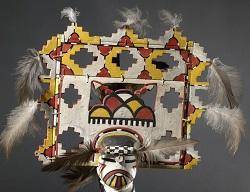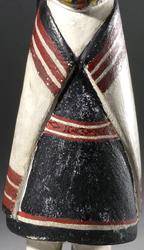
Palhikwmana Katsina
H: 22.5 in., W: 14 in., D: 6 in.
Native Arts acquisition fund, 1938.341
Photograph © Denver Art Museum 2009. All Rights Reserved
While we don’t know who made this particular piece, historically only Hopi men who had completed religious rites of initiation carved katsina figures. A katsina (plural, “katsinam”) is a supernatural being in the Hopi world; a carved katsina figure is also known as tihu (plural, tithu). Traditionally, boys are taught to carve tithu by their uncles and godfathers as part of their initiation into manhood. Women began making katsina figures in the 1930s, but these are considered by the Hopi to be art objects rather than ceremonial objects.
Tithu are given to children, usually girls, during ceremonies and dances when village men impersonate katsinam While some people refer to tithu as “dolls,” they are not toys. They are displayed in the home and used to educate young Hopi girls and familiarize them with the different katsinam. Also, while it’s often seen spelled “kachina,” the Hopi prefer, and it is more appropriate, to use the spelling “katsina.”
The Hopi believe that the katsinam spirits assist in plant growth, prevent misfortune, and—crucially important in the dry Hopi lands of Arizona—bring rain, provided that they are properly respected.
The Palhikwmana katsina is associated with night dances held in March and represents a moisture maiden, “a prayer for early moisture in the form of gentle rain and dew to help the young plants early in the growing season.” In ceremony she dances with a male counterpart.
Hopi culture mandates that tithu are carved out of the root of a cottonwood tree, a symbol of water since it grows close to a water source. As an additional benefit to carvers, the lightness and softness of the cottonwood make it easy to work with.
Details

Headdress
The elaborate headdress on this katsina figure is close to the actual headdress, or tableta, worn by the Palhikwmana katsina dancer in a ceremony. There are several identifiable Hopi symbols:
- The stepped cloud shapes around the edges symbolize rain and renewal, as does the cloud in the center with lightning above and falling rain below.
- A rainbow frames the head of the katsina figure.
- The feathers, most likely meant to imitate eagle feathers.

Face
As painted by the artist, this tihu lacks ears and a nose. The painted chin incorporates several of the traditional directional colors: red (southeast), yellow (northwest), and blue (southwest). Before the introduction of acrylic paints in the 1950s, artists used plant-based pigments, resulting in more subdued colors.
The rectangular checkered object on the forehead represents an ear of corn, an important Hopi crop. A small shell bead hangs from its center.

Cothing
The painted dress of the Pahlikwmana katsina figure echoes the dress of Hopi women: a white shawl, bordered in red and blue, over a black dress held in at the waist by a red belt. The painted white legs might indicate bare legs and feet or could represent the white deerskin boots traditionally worn by Hopi women.
More Resources
Videos
Two Minutes with the Curator: Hopi Butterfly Maiden Kachina
Hear curator Joe Horse Capture from the Minneapolis Institute of the Arts talk about a Hopi Katsina from the MIA's collection.
Funding for object education resources provided by a grant from the Morgridge Family Foundation. Additional funding provided by the William Randolph Hearst Endowment for Education Programs, and Xcel Energy Foundation. We thank our colleagues at the University of Denver Morgridge College of Education.
The images on this page are intended for classroom use only and may not be reproduced for other reasons without the permission of the Denver Art Museum. This object may not currently be on display at the museum.
